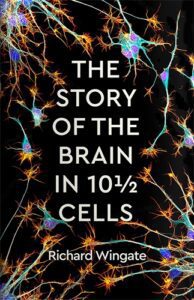Arpan K. Banerjee
Solihull, United Kingdom
 |
| Cover of The Story of the Brain in 10 1/2 Cells by Richard Wingate |
The brain is arguably the most complex organ in the human body, containing more than 100 billion neurons. In this new book, neuroscientist Richard Wingate sets out to describe different types of brain cells, weaving together neuroscience with stories of scientific pioneers who made major contributions to elucidating how the brain works.
Wingate begins by describing his own early research projects. We are soon introduced to pioneers such as the Spanish anatomist Santiago Ramón y Cajal, who conducted research from a small laboratory in his home. As he microscopically examined a section of the brain he had stained with the technique described by Camillo Golgi, with wonder and amazement, he realized that he was unlocking the secrets of brain structure.
The next chapter introduces us to Purkinje cells, which play a prominent part in cerebellar structure. Purkinje was a Czech biologist who incorporated new advances in optics, which enabled more powerful microscopes to be invented with better resolution and images. The organization of Purkinje cells was assumed to represent a precise function in information processing.
The story of the feud between Golgi and Ramón y Cajal is interesting to read. Both were awarded the Nobel Prize in Medicine in 1906, the first ever joint award by the Nobel Foundation. However, the two men were great rivals. Cajal believed Golgi’s stain would enable him to photograph neurons and show a picture of mental processing. His pictures showed the branching structures of brain cells. Golgi, on the other hand, did not believe brain cells existed or that the dendritic tree organized thought. Ramón y Cajal believed that the dendritic tree was a one-way channel for the flow of information; Golgi believed that the brain was an interconnected web of fibers.
The section on retinal ganglion cells and sight introduces us to the work of psychologist and neuroscientist Richard Gregory on the primitive visual system of copepod plankton. Discussion follows about how signals pass between cells. We are reminded of the pioneering work of Galvani from the seventeenth century, who showed that electricity can cause frog muscles to twitch. This led to Edgar Adrian (later Lord Adrian, Nobel Laureate in Medicine 1932) and Keith Lucas’s pioneering work at Cambridge demonstrating the signals of sensory cells in response to stretching muscle. It is interesting to learn that early in his career, Sigmund Freud was also interested in the study of primitive sensory neurons in freshwater crayfish.
During the twentieth century, the study of the neuroanatomy became closely intertwined with neurophysiology as scientists tried to elucidate how brain cells functioned. The pioneering work of electrophysiologist Charles Sherrington is described. He coined the term “synapse” and won the Nobel Prize in 1932 with Edgar Adrian. Sherrington had studied at St. Thomas’ Hospital, London and spent some time as a lecturer in physiology at the medical school there before becoming a professor of physiology at Oxford.
The subject of reticuloendothelial cells leads to a discussion of consciousness, Korbinian Brodmann’s contribution to cortical mapping, and the pioneering neurosurgery of Wilder Penfield. There is a good description of the work of Andrew Huxley and Alan Hodgkin, who are famous for their sliding filament theory and experiments on brain signalling. They shared the Nobel Prize in Medicine in 1963 with John Eccles.
Also included are the topics of artificial intelligence, cybernetics, and the neural net concept of brain function and heterarchy proposed by polymath Warren McCulloch, self-taught genius Walter Pitts, and cybernetics founder Norbert Wiener.
This book is a wonderful description of the cells that make up the brain and how the remarkable organ works. It is well written and easily understood by the general reader. Of particular interest are the stories and vignettes of pioneering neuroscientists, which are beautifully incorporated into the text. The author conveys his passion for neuroscience in this volume, which will leave the reader enthralled and wanting more.
The Story of the Brain in 10 1/2 Cells
Richard Wingate
Profile Books, 2023
ISBN 9781788162968
DR. ARPAN K. BANERJEE qualified in medicine at St Thomas’s Hospital Medical School, London. He was a consultant radiologist in Birmingham 1995–2019. He was President of the radiology section of the RSM 2005–2007 and on the scientific committee of the Royal College of Radiologists 2012–2016. He was Chairman of the British Society for the History of Radiology 2012–2017. He is Chairman of ISHRAD. He is author/co-author of papers on a variety of clinical, radiological, and medical historical topics and seven books, including Classic Papers in Modern Diagnostic Radiology (2005) and The History of Radiology (OUP 2013).

Leave a Reply